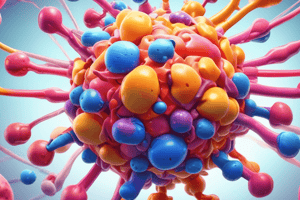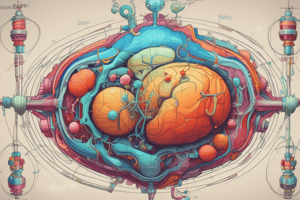Podcast
Questions and Answers
Which of the following best illustrates the principle of homeostasis within the human body?
Which of the following best illustrates the principle of homeostasis within the human body?
- The breakdown of proteins into amino acids during digestion.
- The maintenance of a stable internal body temperature despite external environmental changes. (correct)
- The synthesis of ATP from glucose during cellular respiration.
- The storage of excess glucose as glycogen in the liver.
During the postabsorptive state, which process is primarily responsible for maintaining blood glucose levels?
During the postabsorptive state, which process is primarily responsible for maintaining blood glucose levels?
- Lipogenesis (formation of fat from excess glucose).
- Glycogenolysis (breakdown of glycogen into glucose). (correct)
- Glycogenesis (formation of glycogen from glucose).
- Protein synthesis from amino acids.
Why are essential amino acids a necessary component of the human diet?
Why are essential amino acids a necessary component of the human diet?
- They can be synthesized by the body in sufficient quantities.
- They are required for the synthesis of proteins and cannot be synthesized by the body. (correct)
- They are the primary source of quick energy for the body.
- They are necessary for the breakdown of fats in the liver.
Which of the following lipoproteins is responsible for transporting cholesterol from the body's cells back to the liver for processing and excretion?
Which of the following lipoproteins is responsible for transporting cholesterol from the body's cells back to the liver for processing and excretion?
How does the body respond to maintain its core temperature in a cold environment?
How does the body respond to maintain its core temperature in a cold environment?
What is the primary function of the Citric Acid Cycle (Krebs Cycle) in cellular metabolism?
What is the primary function of the Citric Acid Cycle (Krebs Cycle) in cellular metabolism?
In the context of nitrogen balance, what does a positive nitrogen balance typically indicate?
In the context of nitrogen balance, what does a positive nitrogen balance typically indicate?
How does glycolysis contribute to ATP production in cells, and what are its limitations?
How does glycolysis contribute to ATP production in cells, and what are its limitations?
Which of the following biological processes is primarily an example of anabolism?
Which of the following biological processes is primarily an example of anabolism?
What role does the liver play in the regulation of blood glucose levels?
What role does the liver play in the regulation of blood glucose levels?
Someone with a fever has an elevated body temperature. How does the body typically respond to help lower the temperature back to normal?
Someone with a fever has an elevated body temperature. How does the body typically respond to help lower the temperature back to normal?
What is metabolic turnover, and why is it important for cellular function?
What is metabolic turnover, and why is it important for cellular function?
If someone is consuming a diet that is significantly deficient in calories, essential amino acids and vitamins what condition might they develop?
If someone is consuming a diet that is significantly deficient in calories, essential amino acids and vitamins what condition might they develop?
What is the role of mitochondria in cellular metabolism, and how does it relate to energy production?
What is the role of mitochondria in cellular metabolism, and how does it relate to energy production?
Following a carbohydrate-rich meal, which process is most likely to occur in the body?
Following a carbohydrate-rich meal, which process is most likely to occur in the body?
A marathon runner relies heavily on energy production during the race. Which metabolic process becomes increasingly important to sustain ATP production as the race progresses, and what byproduct might accumulate?
A marathon runner relies heavily on energy production during the race. Which metabolic process becomes increasingly important to sustain ATP production as the race progresses, and what byproduct might accumulate?
How does shivering help maintain body temperature when someone is exposed to a cold environment?
How does shivering help maintain body temperature when someone is exposed to a cold environment?
What is the key difference between VLDLs (Very Low-Density Lipoproteins) and LDLs (Low-Density Lipoproteins) in terms of their function and impact on cardiovascular health?
What is the key difference between VLDLs (Very Low-Density Lipoproteins) and LDLs (Low-Density Lipoproteins) in terms of their function and impact on cardiovascular health?
Which of the following statements correctly describes the difference between the absorptive and postabsorptive states of nutrient metabolism?
Which of the following statements correctly describes the difference between the absorptive and postabsorptive states of nutrient metabolism?
How does Basal Metabolic Rate (BMR) relate to weight management, and what factors can influence it?
How does Basal Metabolic Rate (BMR) relate to weight management, and what factors can influence it?
Flashcards
Nutrition
Nutrition
The process of absorbing nutrients from food to maintain homeostasis and prevent malnutrition.
Balanced Diet
Balanced Diet
Provides necessary substrates for energy, essential amino acids, fatty acids, vitamins, minerals, and water.
Malnutrition
Malnutrition
An unhealthy state caused by inadequate intake of nutrients, calories, and/or vitamins.
Metabolism
Metabolism
Signup and view all the flashcards
Mitochondria
Mitochondria
Signup and view all the flashcards
Metabolic Turnover
Metabolic Turnover
Signup and view all the flashcards
Growth & Cell Division
Growth & Cell Division
Signup and view all the flashcards
Catabolism
Catabolism
Signup and view all the flashcards
Anabolism
Anabolism
Signup and view all the flashcards
Homeostasis
Homeostasis
Signup and view all the flashcards
Liver Functions
Liver Functions
Signup and view all the flashcards
Glycogen
Glycogen
Signup and view all the flashcards
Glucose
Glucose
Signup and view all the flashcards
Adipose tissue
Adipose tissue
Signup and view all the flashcards
Chylomicrons
Chylomicrons
Signup and view all the flashcards
VLDLs
VLDLs
Signup and view all the flashcards
LDLs (Bad)
LDLs (Bad)
Signup and view all the flashcards
HDLs (Good)
HDLs (Good)
Signup and view all the flashcards
Essential Amino Acids
Essential Amino Acids
Signup and view all the flashcards
Absorptive State
Absorptive State
Signup and view all the flashcards
Study Notes
- Nutrition is the process of absorbing nutrients from food to maintain homeostasis and prevent malnutrition.
- A balanced diet provides substrates for energy, essential amino acids, fatty acids, vitamins, minerals, and water.
- Malnutrition is an unhealthy state caused by inadequate nutrient, calorie, and/or vitamin intake.
Cellular Metabolism and Energy Production
- Metabolism maintains bodily function, provides energy, removes waste, and builds muscle.
- Mitochondria provide energy to cells.
- Metabolic turnover involves breaking down old cells and creating new ones.
- Cells grow by making more parts and then divide into two new cells for growth and repair.
Catabolism vs. Anabolism
- Catabolism breaks down food and molecules such as fatty acids and glucose, releasing energy for ATP production.
- Anabolism uses energy from ATP production to build structures like muscles or new body parts.
- ATP is the energy source cells use to perform work.
Homeostasis & Metabolic Regulation
- Homeostasis is the body’s way of maintaining balance.
- The function of the liver is to regulate blood sugar and store nutrients, also directs body on how to utilize food.
- Glycogen is the form of sugar stored in muscles as a backup energy source.
- Glucose is the sugar used by the brain for energy.
- Fat is stored in adipose tissue.
- A small amount of fat in the blood is carried by a protein as free fatty acids.
- Chylomicrons move fat from the intestines to the blood.
- VLDLs take fat from the liver to other body parts.
- LDLs carry cholesterol to the body and can cause heart problems if levels are too high.
- HDLs carry extra cholesterol back to the liver.
- Proteins are made from amino acids.
- Essential amino acids must be obtained from food, while nonessential amino acids can be synthesized by the body.
- Protein breakdown is not ideal for quick energy due to its slow process and waste product generation.
Absorptive vs. Postabsorptive States:
- During the absorptive state, which occurs right after eating, the body stores energy and uses food for fuel.
- In the postabsorptive state, between meals, the body uses stored energy like fat to sustain itself.
- Nitrogen, derived from proteins, is essential for building molecules like DNA.
- Positive nitrogen balance indicates more nitrogen intake than loss, which is good for growth.
- Negative nitrogen balance indicates more nitrogen loss than intake, potentially causing health issues.
Glycolysis & Mitochondrial Reactions
- Glycolysis breaks down glucose for quick energy without oxygen.
- The citric acid cycle and electron transport chain produce much ATP when oxygen is available.
- Glycolysis is quick but yields little ATP and creates lactic acid.
- Mitochondria are slower but produce more ATP with no harmful waste.
- Fat provides the most energy, followed by carbs and proteins.
- Metabolic rate is how fast the body uses energy.
- BMR is the energy used at rest.
- Consuming more energy than used results in fat storage, while burning more than consumed leads to fat loss.
Thermoregulation
- The body produces heat through metabolism.
- Heat loss occurs through sweating and breathing.
Heat control
- In hot conditions, the body sweats and skin turns red to cool down.
- In cold conditions, blood flow is directed away from the skin, and shivering occurs to retain heat.
- Larger individuals lose less heat.
- Babies struggle to maintain warmth but have special fat to assist.
- Fever occurs when body temperature rises to fight infection.
Studying That Suits You
Use AI to generate personalized quizzes and flashcards to suit your learning preferences.




